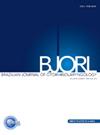Association of tinnitus with obstructive sleep apnea and rapid eye movement-related obstructive sleep apnea in similar hearing threshold groups
IF 1.8
4区 医学
Q2 OTORHINOLARYNGOLOGY
引用次数: 0
Abstract
Objectives
Obstructive sleep apnea, a multisystem disease, affects cochlear and vestibular functions due to chronic intermittent hypoxia and recurrent oxygen desaturation. During rapid eye movement sleep, the muscle tone of the upper airway decreases more, and the cardiovascular complication risk is higher than that during non-rapid eye movement sleep. We analyzed whether tinnitus was associated with obstructive sleep apnea and rapid eye movement-related obstructive sleep apnea in patients with similar hearing thresholds.
Methods
We evaluated patients with obstructive sleep apnea without (24 patients; group 1) and with (27 patients; group 2) tinnitus. All participants underwent pure-tone audiometry, tinnitus tests, polysomnography, and sleep questionnaires.
Results
The sleep efficiency (86.23% ± 10.38% vs. 81.27% ± 8.10%) and Epworth Sleepiness Scale (8.50 ± 4.31 vs. 5.15 ± 2.82) values were higher in group 2 versus group 1. In patients with rapid eye movement-related obstructive sleep apnea, the sleep efficiency value was higher in group 2 (90.55% ± 4.61%) versus group 1 (78.13% ± 11.70%). However, in patients with obstructive sleep apnea and rapid eye movement-related obstructive sleep apnea, medication use that might affect sleep was higher in group 2 (44.4% and 54.4%, respectively) versus group 1 (16.7% and 28.6%, respectively).
Conclusions
We evaluated the relationship between tinnitus and obstructive sleep apnea or rapid eye movement-related obstructive sleep apnea in groups with similar hearing thresholds for the first time. The presence of tinnitus in patients with obstructive sleep apnea with similar hearing thresholds was more closely related to subjective parameters than to objective parameters. Patients with tinnitus had poorer sleep quality than those without tinnitus.
Level of evidence
4.
耳鸣与阻塞性睡眠呼吸暂停和快速眼动相关阻塞性睡眠呼吸暂停在相似听力阈组的关联
目的阻塞性睡眠呼吸暂停是一种多系统疾病,慢性间歇性缺氧和反复氧饱和度降低影响耳蜗和前庭功能。快速眼动睡眠时,上气道肌张力下降幅度更大,心血管并发症风险高于非快速眼动睡眠。我们分析了耳鸣是否与听力阈值相似的患者的阻塞性睡眠呼吸暂停和快速眼动相关的阻塞性睡眠呼吸暂停有关。方法对阻塞性睡眠呼吸暂停患者(24例;1组27例;第二组耳鸣。所有参与者都进行了纯音听力学、耳鸣测试、多导睡眠描记仪和睡眠问卷调查。结果2组患者睡眠效率(86.23%±10.38% vs. 81.27%±8.10%)和Epworth嗜睡量表(8.50±4.31 vs. 5.15±2.82)均高于1组。在快速眼动相关性阻塞性睡眠呼吸暂停患者中,2组睡眠效率值(90.55%±4.61%)高于1组(78.13%±11.70%)。然而,在阻塞性睡眠呼吸暂停和快速眼动相关的阻塞性睡眠呼吸暂停患者中,2组可能影响睡眠的药物使用(分别为44.4%和54.4%)高于1组(分别为16.7%和28.6%)。结论首次在听力阈值相近的人群中评估耳鸣与阻塞性睡眠呼吸暂停或快速眼动相关性阻塞性睡眠呼吸暂停的关系。听力阈值相近的阻塞性睡眠呼吸暂停患者出现耳鸣与主观参数的关系大于与客观参数的关系。耳鸣患者的睡眠质量较无耳鸣患者差。证据水平4。
本文章由计算机程序翻译,如有差异,请以英文原文为准。
求助全文
约1分钟内获得全文
求助全文
来源期刊

Brazilian Journal of Otorhinolaryngology
OTORHINOLARYNGOLOGY-
CiteScore
3.00
自引率
0.00%
发文量
205
审稿时长
4-8 weeks
期刊介绍:
Brazilian Journal of Otorhinolaryngology publishes original contributions in otolaryngology and the associated areas (cranio-maxillo-facial surgery and phoniatrics). The aim of this journal is the national and international divulgation of the scientific production interesting to the otolaryngology, as well as the discussion, in editorials, of subjects of scientific, academic and professional relevance.
The Brazilian Journal of Otorhinolaryngology is born from the Revista Brasileira de Otorrinolaringologia, of which it is the English version, created and indexed by MEDLINE in 2005. It is the official scientific publication of the Brazilian Association of Otolaryngology and Cervicofacial Surgery. Its abbreviated title is Braz J Otorhinolaryngol., which should be used in bibliographies, footnotes and bibliographical references and strips.
 求助内容:
求助内容: 应助结果提醒方式:
应助结果提醒方式:


